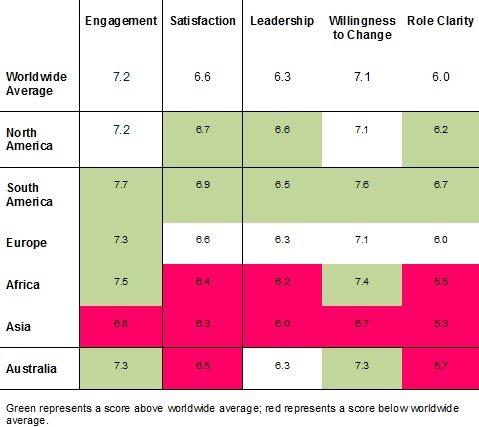Employee engagement has become one of the top human capital concerns of U.S. companies.
As executives are contending with this issue for their U.S. workforce, they are finding that their operations in the rest of the world are having similar problems. Executives are realizing that employee engagement is a global issue.
Which countries have higher engagement scores, and which have lower scores?
Why engagement is a global problem
Here are some brief facts on global engagement:
- Just two-thirds of employees worldwide are engaged.
- Company loyalty is at a five (5) year low.
- More than 40 percent of the global workforce intends to leave their current employer within five (5) years.
- Employee engagement across the world has stagnated at 2008 levels,
Companies need to understand how engagement and its drivers differ by region. They can then segment their workforce and target engagement programs appropriately.
Employee Engagement by region
Where do people take pleasure in their work? Where do people like to go the extra mile for their company?
Let’s look at global engagement scores by region. This 2011 survey by Effectory was conducted among over 12,000 respondents in 47 countries. The scores were based on a 10-point scale, 10 being the most positive.
- Europe: Confidence in management and the future is low, and that negatively influences engagement. Employees in Northern/Western Europe score higher on willingness to change and retention. Giving trust and reaching consensus is key. Employees in Southern Europe believe they have a negative working environment, and have low efficiency, low motivation and low productivity. Role clarity and leadership also receive low scores. So although there are differences between the two regions, the overall scores are OK.
- North America: The satisfaction with immediate co-workers and their motivation is a point of particular concern. Scores seem to be at the global average with Engagement and Willingness to Change. Satisfaction, Leadership and Role Clarity are a little above the average. (This may be a shock to readers!)
- Asia: Asia has not suffered economically like the Western world has. Consequently jobs are more plentiful. In China and India in particular, employees are quick to leave an employer if they don’t believe there is enough career development opportunity. Key is the ability to “job-hop” for more money and bigger job titles. Being treated with respect and quality of leadership are cited by employees as most influential to their motivation and engagement at work. Don’t be fooled by the overall low scores. They are almost totally due to the very low scores by Japan. Overall most of Asia is at the global average.
- Japan: It has had a depressed economy for 20 plus years, which is the largest cause of lower employee engagement. Japanese employees are virtually disengaged, but they also have no intention of leaving, which doesn’t do much for productivity. Employees not only don’t care about their jobs, but they are upset with their company and their managers and spread this malaise to those around them. Job security is the main concern and engagement takes second place to that. Japan’s scores really pull down the Asia composite scores.
- China: For workers in China, employee engagement is more influenced by their perceptions of fair pay than by their satisfaction with recognition. Money has historically been the primary motivator for Chinese employees. This focus on pay could also be due to the speed of economic growth in their country and the extreme demand for talent which drives up pay levels. Pay then, unlike other countries — with the possible exception of India — is the most important driver.
- Australia: The workload reduces the fitness and health of employees that in turn gives rise to stress and low productivity. Employees view their leaders as effective in building business strategies, but feel there are low scores in Role Clarity of their company’s future direction and overall levels of confidence in leaders. Employees perceive that their organization’s ability to clearly articulate available career paths is low. Australia also scores low on Satisfaction.
- South America: This region has the highest scores. Employees are proud and due to their strength in the global marketplace they work very long hours. Reducing the workload would produce more engaged employees. A huge 74 percent of South American workers feel motivated to go beyond their formal job responsibilities. South America also enjoys the highest levels of employee pride.
- South Africa: Employees find themselves working under very poor conditions. There is low confidence in job security. Employees show lower intention to stay with their employer regardless of career status. Employees feel they are not properly engaged through their supervisors. The low scores are for Satisfaction, Leadership and Role Clarity.
Conclusion
There are varying weaknesses and strengths in the specific areas of employee engagement across the world. Understanding the differences is important.
Just like many other talent management programs in multinational companies, one size does not fit all worldwide. Employee engagement programs need to be tailored to meet specific needs.
